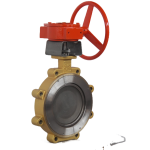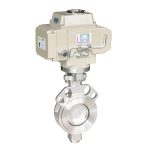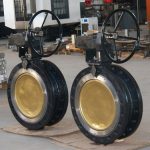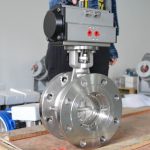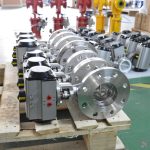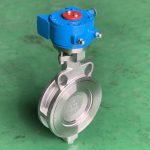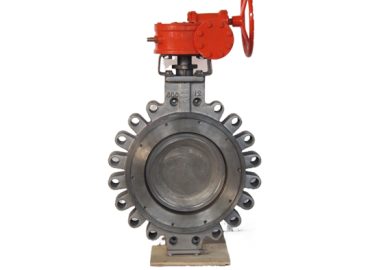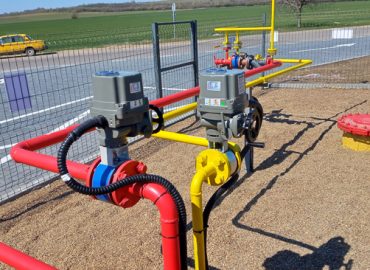In the world of fluid control, butterfly valve hold a pivotal role due to their efficiency and versatility. These devices regulate the flow of liquids through a section of pipe, playing a crucial part in many industrial applications. However, not all butterfly valve are created equal. There are three main types – Zero, Double, and Triple Offset Butterfly Valve – each with distinct design features, advantages, and uses. This blog post aims to decipher the differences between these three types, shedding light on their unique characteristics and providing guidance on selecting the right type for specific applications. Let’s dive in to uncover the fascinating world of butterfly valve.
Introduction
Butterfly valve, a crucial component in fluid control systems, come in three main types: Zero, Double, and Triple Offset Butterfly Valve. The differences lie in their design and functionality. Starting with the Zero Offset Butterfly Valve, this variant has a simple yet effective design where the disc rotates around the center axis. This results in a 90-degree rotation that allows for complete shut-off or full flow of the fluid. However, the disc’s constant contact with the seat can lead to wear and tear over time, making this type less suitable for high-temperature, high-pressure, or corrosive applications. Moving on to the Double Offset Butterfly Valve, the stem is offset from the centerline of the disc and from the centerline of the body, allowing the disc to move off the seat in a cam-like motion, reducing wear and tear. This design enhancement makes it a better fit for medium pressure and temperature applications. Finally, the Triple Offset Butterfly Valve takes the design sophistication a step further. The third offset involves a conical shape of the seating surfaces, ensuring a tight seal with minimal wear. This design eliminates any rubbing action between the sealing surfaces, making it ideal for handling higher pressures, temperatures, and corrosive media. The choice between these three types depends largely on the specific application and the conditions under which the valve will operate. Understanding the differences can help in selecting the most suitable butterfly valve for any given situation.
Brief description of butterfly valve.
Butterfly valve are a type of quarter-turn valve used to regulate and isolate the flow of liquids in a pipeline. The name “butterfly” comes from the wing-like action of the disc, which is the primary component of the valve. When the valve is fully open, the disc is rotated a quarter turn so that it allows an almost unrestricted passage of fluid. When the valve is closed, the disc is rotated a quarter turn to block off the passage. Butterfly valves are known for their simplicity, durability, and ease of operation. They’re widely used across various industries due to their cost-effectiveness, compact design, and versatility in handling different types of fluids and gases at various pressure levels.
Importance of butterfly valve in fluid control.
Butterfly valves play a significant role in fluid control systems due to their ability to regulate the flow of various liquids and gases efficiently. Their compact design and simple operation make them ideal for controlling large flow volumes in a variety of industrial applications, ranging from water distribution, chemical processing, power generation, and more. The quarter-turn operation of butterfly valves provides fast and easy flow isolation, which is particularly useful in emergency situations where rapid shutoff is required. Furthermore, with their tight sealing capabilities, they effectively prevent leaks, contributing to the safety and efficiency of fluid management systems. Moreover, their versatility in handling different types of fluids at varying pressure levels makes them an invaluable component in fluid control, enhancing operational reliability and process control in many industries.
Overview of the blog post.
This blog post provides an in-depth exploration of butterfly valves, focusing on their crucial role in fluid control systems. We delve into the different types of butterfly valves – Zero, Double, and Triple Offset – and decipher their unique design features and functionalities. By understanding the differences between these types, we help readers select the most suitable butterfly valve for their specific applications. We further highlight the importance of butterfly valves in effectively regulating the flow of liquids and gases across various industrial contexts. From water distribution to chemical processing and power generation, we emphasize the versatility and efficiency of butterfly valves in managing large flow volumes, ensuring rapid shutoff in emergencies, and preventing leaks. With this comprehensive overview, readers will gain a deeper appreciation for these indispensable components in fluid control systems.
-450x450.jpg)
Understanding Butterfly Valve
Butterfly valves are a unique type of quarter-turn valve that play a crucial role in controlling the flow of various mediums – be it liquid, gas, or particulate solids – in numerous sectors, including water treatment, chemical industries, and power generation. At the heart of their design is a disc mounted on a rotating shaft. When the valve is fully open, the disc pivots a quarter turn to allow an almost unrestricted flow of fluid. Conversely, when the valve is closed, the disc is rotated back to block the flow. There are typically three types of butterfly valves: Zero Offset, Double Offset, and Triple Offset. The Zero Offset Butterfly Valve has a rubber seat with a resilient-seated design. This design allows for lower pressure applications. On the other hand, the Double Offset Butterfly Valve, also known as a high-performance butterfly valve, has two offsets that create a cam-like motion during operation. This allows for higher pressure and temperature tolerance. Lastly, the Triple Offset Butterfly Valve, also known as a triple eccentric butterfly valve, has three different offsets that provide even higher pressure and temperature capabilities. These valves are perfect for critical applications that require zero leakage. What sets butterfly valves apart is their simplicity, durability, and cost-effectiveness. Their compact design makes them lighter and smaller than other valve types, meaning they require less support, which leads to lower costs in terms of installation and maintenance. Furthermore, their easy operation enables quick and efficient control of flow, making them ideal for applications that require frequent operation and regulation of flow. With these features, butterfly valves have become an invaluable tool in fluid management systems, providing reliable and efficient flow control solutions.
Detailed explanation of what butterfly valve are.
Butterfly valves are a type of quarter-turn valve that offer efficient control over the flow of fluids. They consist of a circular disc or plate with its pivot axis at right angles to the direction of flow in the pipe, which acts as the closing mechanism. They are typically used in systems where a fast shutoff is desired. When the valve is closed, the disc is turned so that it completely blocks off the passageway. When the valve is fully open, the disc is rotated a quarter turn so it allows an almost unrestricted passage of the fluid. The butterfly valve is so named because of the wing-like action of the disc during the opening and closing operations. It’s also known for its tight sealing and high levels of leak prevention. There are three types of butterfly valves: concentric, double-offset, and triple-offset. Each type has different applications and uses depending on their design and material make-up. Butterfly valves are widely utilized in various industries due to their cost-effectiveness, long service life, and ability to withstand extreme pressure and temperature conditions.
Discussion on how butterfly valve work.
Butterfly valves operate on a fairly simple principle. The central feature of the valve is a disc that’s mounted on a rotating shaft. By turning the valve handle, this disc, which is positioned in the middle of the pipe, rotates. When the handle is turned a quarter of the way, the disc turns to either fully block the flow of fluid (when it’s perpendicular to the flow) or to allow it to pass through unrestricted (when it’s parallel to the flow). This quick on-off response is one of the key benefits of butterfly valves. The disc’s rotation is facilitated by the stem, which connects the actuator (a handle or gear) to the disc. The stem is designed such that it passes right through the disc, or it is offset, allowing the disc to move without coming into contact with the valve body. This offset design helps reduce wear and tear on the valve, enhancing its lifespan. In some cases, a seal or seat may be incorporated to further prevent any potential leakage when the valve is closed. Thus, through the simple rotation of a disc, marine butterfly valves effectively manage the flow of fluids within a system.
The role and significance of butterfly valve in different industrial applications.
Butterfly valves play a significant role in various industrial applications due to their effectiveness in controlling and isolating the flow of different mediums, including liquids, gases, and semi-solids. In the water and wastewater industry, for instance, these valves are used in filtration units, water cooling systems, and as shut-off valves in water distribution networks. They are also essential in the oil and gas industry, where they are used in processing plants for throttling service and to control fluid flow during extraction and refining processes. In the chemical industry, butterfly valves are utilized for their ability to handle a wide range of temperatures and pressures, making them suitable for controlling the flow of aggressive chemicals. Their easy operation and tight sealing properties make them ideal for applications that demand quick shut-off, such as fuel handling systems in the aviation and marine industries. Furthermore, in heating, ventilation, and air conditioning (HVAC) systems, butterfly valves regulate the flow of hot and cold air throughout the system, ensuring optimal indoor climate control. Thus, the versatility, reliability, and cost-effectiveness of butterfly valves make them indispensable in various industrial settings.
Zero Offset Butterfly Valve
Zero offset butterfly valves, also known as concentric butterfly valves, are a type of butterfly valve in which the stem is centered in the middle of the valve disc, and the disc is centered in the body of the valve. This alignment means that the disc and the stem rotate around the same axis, hence the term “zero offset.” When the valve is opened or closed, the disc rotates in the center of the pipe without any displacement. The advantage of this design is its simplicity and cost-effectiveness; however, it can result in more wear and tear on the valve seat when the valve is opened and closed, as the disc comes into full contact with the seat every time the valve is operated. Despite this, zero offset butterfly valves are highly effective for moderate temperature applications and for handling water and other non-aggressive fluids. They are commonly used in water distribution systems, cooling systems, and HVAC systems due to their ability to provide reliable shutoff with minimal pressure drop. Their lightweight design and smaller footprint compared to other types of valves make them a popular choice for many industrial applications where space and weight are considerations. The ease of operation, combined with their ability to handle a wide range of flow rates, further contributes to their widespread use in various industries.
Detailed explanation of zero offset butterfly valve.
Zero offset butterfly valves, also known as concentric butterfly valves, exhibit a straightforward yet effective design. The valve’s disc is placed in the direct center of the pipe, and the stem is also centered in the disc. This alignment means that the disc rotates around the same axis as the stem, hence the term “zero offset.” When the valve is opened or closed, the disc rotates without any displacement, which allows for the direct and efficient control of fluid flow. Despite its simplicity, this design does have a drawback. The disc comes into direct contact with the valve seat each time the valve is operated, resulting in more wear and tear over time. Nonetheless, zero offset butterfly valves are ideal for moderate temperature applications and are suitable for handling non-aggressive fluids like water. They are commonly used in applications where space and weight are considerations due to their lightweight design and smaller footprint. Furthermore, their ease of operation and ability to handle a wide range of flow rates make them a popular choice in industries like water treatment, HVAC systems, and cooling systems.
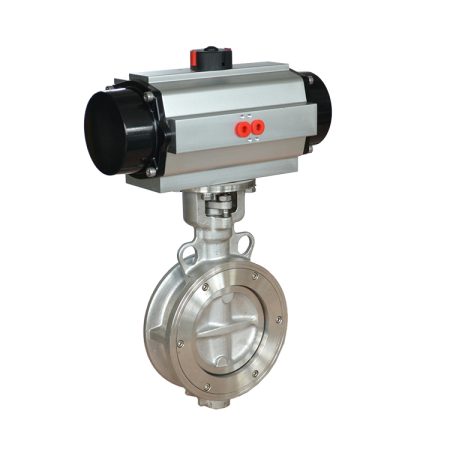
The design and operation of zero offset butterfly valve.
Zero offset butterfly valves, also known as concentric butterfly valves, are characterized by a simple yet efficient design where the stem is located in the middle of the valve disc, and the disc itself is centered within the body of the valve. This configuration leads to the “zero offset” designation, meaning that the disc and the stem rotate around the same axis without any deviation. When the valve is operated, either to open or close, the disc rotates in place, directly controlling the fluid flow without displacement. The design, while effective, does have its drawbacks. Each time the valve is operated, the disc comes into full contact with the seat, leading to increased wear and tear over time. However, zero offset butterfly valves are highly suitable for applications with moderate temperatures and non-aggressive fluids, such as water. They’re commonly used in industries where space is a premium due to their lightweight design and smaller footprint compared to other types of valves. Additionally, their ease of operation and ability to handle various flow rates make them a preferred choice in numerous sectors, including water treatment, HVAC systems, and cooling systems.
Advantages and disadvantages of zero offset butterfly valve.
Zero offset butterfly valves, also known as concentric butterfly valves, offer several advantages. Their simple design, characterized by the stem being centered in the disc and the disc being centered in the valve body, allows for straightforward operation and direct control of fluid flow. This design also results in a lightweight valve with a small footprint, making it ideal for applications where space is at a premium. Furthermore, these valves are cost-effective to produce and maintain, and they can handle a wide range of flow rates, making them versatile for various industrial applications. However, there are also some disadvantages associated with zero offset butterfly valves. One of the main drawbacks is that the disc comes into full contact with the valve seat each time the valve is operated, which can lead to increased wear and tear over time, potentially reducing the lifespan of the valve. Furthermore, these valves are not suitable for high-temperature applications or for handling aggressive fluids due to the potential for damage to the valve seat. As such, while zero offset butterfly valves are beneficial in many contexts, their suitability must be evaluated based on the specifics of the application.
Specific use cases and industries where zero offset butterfly valves are commonly used.
Zero offset butterfly valves, also known as concentric butterfly valves, are commonly used in a variety of industries due to their simple design, ease of operation, and ability to handle different flow rates. In the water treatment industry, these valves are often used to control the flow of water through pipelines, given their efficiency in handling non-aggressive fluids. They’re also prevalent in HVAC (Heating, Ventilation, and Air Conditioning) systems, where they regulate the flow of coolant or heating fluid, contributing to the overall temperature control of the environment. The lightweight design and small footprint of zero offset butterfly valves make them suitable for cooling systems in industries like power generation and processing plants. Here, they control the flow of cooling water or other fluids to maintain optimal operating conditions. These valves are also seen in the food and beverage industry for managing the flow of non-aggressive liquids during various production stages. However, it’s important to note that while zero offset butterfly valves are versatile, their application should be considered based on the specifics of the task at hand, especially concerning the temperature and type of fluid involved.
Double Offset Butterfly Valve
Double offset butterfly valves, also known as high-performance butterfly valves, are a significant advancement over the traditional zero offset (or concentric) butterfly valves. The unique design of these valves introduces two ‘offsets’. The first offset involves the positioning of the stem behind the disc, which allows the disc to pivot around a point located on its diameter. The second offset is achieved by placing the centerline of the bore slightly behind the centerline of the disc. This double offset design results in a cam-like motion during operation, where the disc is quickly lifted away from the seat reducing friction and wear, thus enhancing the lifespan of the valve. As the valve closes, the disc’s cam action enables it to gradually contact the seat, creating a tighter and leak-proof seal.
The double offset design makes these valves suitable for more demanding applications that require higher pressure and temperature tolerances. They can handle a wider range of fluids, including corrosive and abrasive ones, making them versatile for use in various industries such as oil and gas, chemical processing, power generation, and water treatment. Additionally, they offer better throttling capabilities than zero offset valves, providing more precise control over fluid flow. Despite their higher initial cost compared to zero offset valves, the long-term benefits of reduced maintenance costs and increased durability make double offset butterfly valves a cost-effective solution for many industrial applications. However, it’s crucial to note that while these valves offer improved performance and versatility, they still might not be suitable for some extreme conditions, such as very high-pressure scenarios or when dealing with particularly aggressive media. In these cases, a triple offset butterfly valve may be more appropriate.
Detailed explanation of double offset butterfly valves.
Double offset butterfly valve, also known as high-performance butterfly valves, are characterized by two distinct offsets. The first offset is the way the stem is positioned behind the disc, rather than centered in the middle, as seen in zero offset butterfly valves. This positioning allows the disc to pivot around a point on its diameter, not at the center, making it possible for the valve to operate without the disc scraping against the body of the valve. The second offset involves positioning the centerline of the bore slightly behind the centerline of the disc. This causes the valve disc to move off the seat in a cam-like or swinging motion as soon as the valve starts to open.
The primary advantage of this double offset design is that the disc’s contact with the seat is minimized during operation, reducing wear and tear and extending the valve’s lifespan. The cam-like action also allows for gradual contact between disc and seat as the valve closes, creating a tighter seal, which improves leak-resistance. Moreover, double offset butterfly valves can handle higher pressure and temperature ranges and more abrasive or corrosive fluids, enhancing their versatility across industries such as oil and gas, chemical processing, power generation, and water treatment. Despite their higher initial cost compared to concentric butterfly valves, these valves often prove more cost-effective in the long run due to reduced maintenance costs and increased durability. However, they may not be suitable for extreme conditions, where triple offset butterfly valves might be better suited.
The design and operation of double offset butterfly valves.
Double offset butterfly valves, otherwise known as high-performance butterfly valves, have a unique design and operation that distinguishes them from other types of valves. In these valves, the stem is placed behind the disc (the first offset) and the centerline of the bore is slightly behind the centerline of the disc (the second offset). This double offset configuration allows the disc to move in a cam-like or swinging motion, quickly moving away from the seat as the valve is opened, thereby reducing friction and wear on the disc and seat.
When the valve is operated, the stem turns, causing the disc to pivot around a point on its diameter, which results in a minimal, gradual contact between the disc and the seat. This unique movement creates a tighter seal when the valve is closed and reduces the scraping of the disc against the seat, enhancing the lifespan of the valve.
Double offset butterfly valves are particularly suitable for applications requiring higher pressure and temperature tolerances. They can handle a variety of fluid types, including corrosive and abrasive ones, making them versatile for use in various industries such as oil and gas, chemical processing, power generation, and water treatment. However, for extreme conditions, a triple offset butterfly valve may be more appropriate. Despite their higher initial cost, the durability and reduced maintenance costs of double offset butterfly valves often make them a cost-effective choice in the long run.
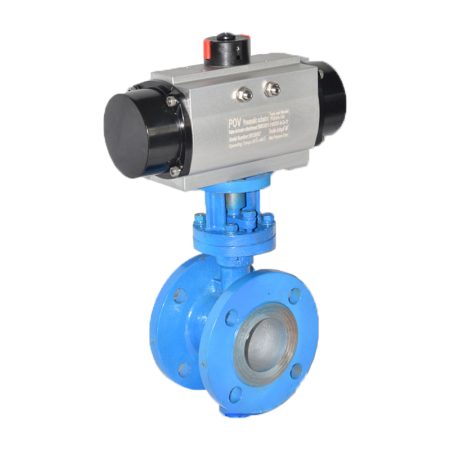
Advantages and disadvantages of double offset butterfly valves.
Double offset butterfly valves, also known as high-performance butterfly valves, come with several advantages. The most significant of these is their ability to handle higher pressure and temperature ranges compared to traditional butterfly valves, thanks to their unique double offset design. This design allows the disc to move off the seat immediately upon valve opening, minimizing wear and tear on both the disc and the seat, thereby extending the valve’s lifespan. The cam-like action of the disc during operation enables a tighter seal when the valve is closed, improving its leak-resistance. These valves can also handle a variety of fluid types, including corrosive and abrasive ones, enhancing their versatility across different industries.
However, double offset butterfly valves do have some disadvantages. Firstly, they are typically more expensive upfront than standard butterfly valves due to their complex design. Although they can prove more cost-effective in the long run due to reduced maintenance costs and increased durability, the initial investment can be a deterrent for some. Secondly, while these valves are suitable for many applications, they may not be ideal for extreme conditions, such as very high-pressure scenarios or when dealing with particularly aggressive media. In such cases, a triple offset butterfly valve might be a better choice. Lastly, despite their improved sealing capabilities, they may still allow slight leakage when closed, which might not be acceptable in certain critical applications.
Specific use cases and industries where double offset butterfly valves are commonly used.
Double offset butterfly valves, known for their high performance and durability, are commonly used across a variety of industries due to their ability to handle higher pressure and temperature ranges, as well as a diverse range of fluid types. In the oil and gas industry, these valves are often utilized in pipelines and processing equipment to control the flow of crude oil, natural gas, and processed petroleum products. They are also widely used in power generation plants, where they serve critical roles in boiler feed water systems, cooling water circuits, and steam turbine systems.
In the chemical processing industry, double offset butterfly valves are preferred for their ability to withstand corrosive and abrasive fluids, playing a vital role in controlling the flow of various chemicals during processing. Water treatment plants also use these valves, particularly in sludge handling and wastewater treatment processes, due to their robustness and leak-resistant properties.
In addition, these valves find applications in the HVAC sector for regulating airflow in large duct systems. They are also found in fire protection systems, where their quick and reliable operation is crucial. Despite their higher upfront cost compared to standard butterfly valves, the reduced maintenance costs, increased durability, and versatility make double offset butterfly valves a preferred choice in these industries.
Triple Offset Butterfly Valves
Triple offset butterfly valves, also known as triple eccentric butterfly valves, represent a further development of the double offset butterfly valve design. These valves incorporate a third ‘offset’ into their design which involves a conical shape of the sealing surfaces. The first offset is the location of the stem behind the disc, the second offset is the placement of the stem’s axis away from the centerline of the bore, and the third offset is the geometry of the seating surface, introducing a conical profile that ensures a tight shutoff.
This triple offset design eliminates any rubbing action between the sealing surfaces during operation, which significantly reduces wear and increases the durability of the valve. The sealing system in these valves is metal-to-metal, providing excellent sealing capabilities, even under high-pressure and high-temperature conditions. The tight shutoff capability of these valves makes them suitable for critical applications where zero leakage is required.
Triple offset butterfly valves are highly versatile and can handle a wide range of media, including corrosive and abrasive fluids, gases, and steam. They are widely used in industries such as oil and gas, power generation, chemical processing, and water treatment, where they can manage demanding applications reliably and efficiently.
Despite their numerous advantages, triple offset butterfly valves do have a higher upfront cost compared to other types of butterfly valves due to their more complex design. However, their longer lifespan, reduced maintenance requirements, and superior performance often justify this initial investment, making them a cost-effective solution over the long term. Their compact design and lighter weight compared to traditional gate or globe valves also make them a preferred choice in space-constrained installations. The ability to offer bidirectional operation and quarter-turn functionality makes them easy to operate and control, further enhancing their appeal in various industrial applications.
Detailed explanation of triple offset butterfly valves.
Triple offset butterfly valve, also known as triple eccentric butterfly valves, are a type of butterfly valve that has been engineered with three separate offsets. The unique design of these valves offers several advantages over traditional butterfly valves, especially in terms of sealing and longevity.
The first offset is the shaft placement behind the disc, similar to conventional butterfly valves. This allows for a complete 360-degree rotation of the disc. The second offset involves the shift of the shaft’s axis away from the centerline of the bore, which enables the disc to move off the seat immediately upon valve opening, reducing wear and tear.
The third offset, which is what truly distinguishes these valves, involves the geometry of the seating surface. Unlike traditional butterfly valves that have a concentric or eccentric seating surface, triple offset butterfly valves have a conical shape of the sealing surfaces. This conical profile ensures a tight shutoff and eliminates any rubbing action between the sealing surfaces during operation.
This design feature allows triple offset butterfly valves to provide ‘zero leakage’ performance, making them suitable for critical applications where even the slightest leakage can’t be tolerated. It also significantly reduces wear and tear on the valve components, extending the valve’s lifespan and reducing maintenance requirements.
These valves can handle a wide range of operating conditions and media types, including high-pressure and temperature applications and corrosive and abrasive fluids. Despite their higher upfront cost due to the complex design, they often prove to be a cost-effective solution over the long term due to their superior performance and durability. They are commonly used in industries such as oil and gas, petrochemicals, power generation, water treatment, and more.
The design and operation of triple offset butterfly valves.
Triple offset butterfly valves, also known as triple eccentric butterfly valves, are designed with three distinct offsets to improve their performance, durability and sealing capabilities. The first offset is the positioning of the stem behind the disc, which allows for a complete 360-degree rotation of the disc. The second offset is the shift of the stem’s axis away from the centerline of the bore or pipe, which ensures that the disc moves immediately off the seat as the valve opens, reducing wear and tear.
The third offset, the unique feature that sets these valves apart, involves the geometry of the seating surface. Instead of a concentric or simply eccentric seating surface, triple offset butterfly valves have a conical shape of the sealing surfaces. This design eliminates any rubbing action between the sealing surfaces during operation, which significantly reduces wear and extends the valve’s lifespan.
In terms of operation, when the valve is closed, the conical shaped disc seals tightly against the valve seat, providing a ‘zero leakage’ seal. As the valve is opened, the disc moves away from the seat without any rubbing action, preventing wear and ensuring a longer operational life. When fully open, the disc allows for maximum flow with minimal pressure drop. Because of their design and operation, triple offset butterfly valves are ideal for applications involving high temperatures, high pressures, and corrosive fluids, and are commonly used in industries such as oil and gas, chemical processing, and power generation.
Advantages and disadvantages of triple offset butterfly valves.
Triple offset butterfly valves offer a number of advantages in various applications. The primary advantage is their ability to provide a tight, ‘zero leakage’ seal due to the conical shape of the sealing surfaces. This makes them suitable for critical applications where even minor leakage can’t be tolerated. They also exhibit minimal wear and tear during operation as there’s no rubbing between the sealing surfaces, extending the valve’s lifespan and reducing maintenance requirements. Furthermore, these valves can handle a wide range of operating conditions and media types, including high-pressure and high-temperature applications, as well as corrosive and abrasive fluids. Their compact design and lighter weight compared to traditional gate or globe valves also make them a preferred choice in space-constrained installations.
However, triple offset butterfly valves also have some disadvantages. The complex design of these valves results in a higher upfront cost compared to other types of butterfly valves. While they prove to be cost-effective over the long term due to their superior performance and durability, the initial investment can be a deterrent for some. Additionally, while these valves are designed to handle a wide range of conditions, they may not be suitable for certain extreme applications. For example, in extremely high-pressure scenarios, ball valves or gate valves might be a better fit. Similarly, for very thick or slurry-type fluids, a different type of valve might perform better. Lastly, the installation and maintenance of these valves require trained personnel due to their complexity.
Specific use cases and industries where triple offset butterfly valves are commonly used.
Triple offset butterfly valves are used widely across various industries due to their robust design, high performance, and ‘zero leakage’ sealing capabilities. In the oil and gas industry, these valves are often used in pipeline transportation systems, processing plants, and offshore platforms due to their ability to handle high-pressure and high-temperature conditions, as well as their resistance to corrosive media.
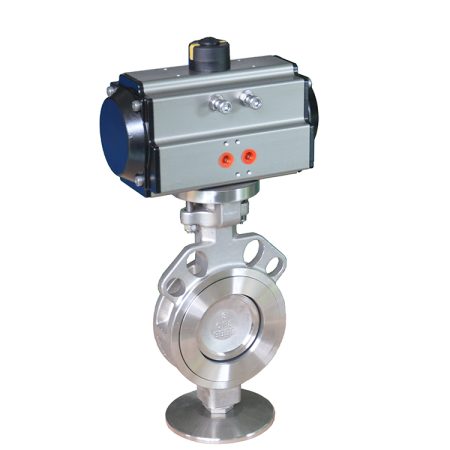
The petrochemical industry also utilizes these valves for similar reasons, especially in processes that involve corrosive and abrasive fluids. In power generation plants, triple offset butterfly valves are commonly used in boiler and cooling water systems, feed water control systems, and steam conditioning systems. Their ability to provide a tight seal and handle high-temperature conditions makes them ideal for these applications.
Water and wastewater treatment plants use these valves for flow control and isolation purposes. Their ‘zero leakage’ performance is particularly important in these applications to prevent contamination of the water supply. The pulp and paper industry uses them in various stages of the production process, where they must handle abrasive slurries and other challenging media.
In addition, these valves are also found in HVAC systems, shipbuilding, and even in fire protection systems. Regardless of the application, the use of triple offset butterfly valves often results in lower maintenance requirements and longer service life, leading to cost savings over the long term.
Comparing Zero, Double, and Triple Offset Butterfly Valves
Butterfly valves are a popular choice in various industries due to their simple design, ease of operation, and cost-effectiveness. However, depending on the specific application, different types of butterfly valves – zero, double, and triple offset – might be used.
Starting with zero offset butterfly valves, also known as concentric butterfly valves, these are the simplest and most common type. The stem is located in the center of the disc, and the disc is located in the center of the pipe bore. This configuration allows for a 360-degree rotation of the disc. However, the disc and the seat are in constant contact during opening and closing, which can cause wear and tear over time. Zero offset butterfly valves are best suited for low-pressure and low-temperature applications, typically handling water and other non-aggressive media.
Double offset butterfly valves, or high-performance butterfly valves, have two offsets. The first offset is the stem placement, which is behind the disc, allowing the disc to pivot without friction against the seat. The second offset involves shifting the stem’s axis away from the centerline of the bore. This design ensures that the disc moves immediately off the seat as the valve opens, reducing wear and tear. These valves can handle higher pressures and temperatures than zero offset valves and offer better sealing capabilities. However, they may still experience some leakage.
Triple offset butterfly valves, the most advanced type, incorporate a third offset – a conical shape of the sealing surfaces. This eliminates any rubbing action between the sealing surfaces during operation, which significantly reduces wear and extends the valve’s lifespan. Moreover, this design allows for ‘zero leakage,’ making these valves suitable for critical applications involving high temperatures, high pressures, and corrosive fluids. However, the complexity of their design leads to a higher upfront cost compared to the other types.
In summary, zero offset butterfly valves are a cost-effective solution for low-pressure and low-temperature applications, double offset valves offer improved performance and reduced wear for medium to high-pressure applications, while triple offset valves provide the highest performance and ‘zero leakage’ sealing for the most demanding applications. The choice between these types depends on the specific requirements of the application, including the operating pressure and temperature, the type of media to be controlled, and the acceptable level of leakage.
Direct comparison of the three types of butterfly valves.
When comparing zero, double, and triple offset butterfly valves, several factors come into play, including design, performance, cost, and application suitability. Zero offset butterfly valves, also known as concentric butterfly valves, have the simplest design and are the most cost-effective. They are suitable for low-pressure and low-temperature applications, handling non-aggressive media like water. However, they experience wear and tear due to constant contact between the disc and seat during operation, which can lead to leakage over time.
Double offset butterfly valves, on the other hand, have a more complex design that reduces wear and tear, enhancing their durability. The offset stem placement allows the disc to pivot without friction against the seat, reducing wear and allowing these valves to handle higher pressures and temperatures than zero offset valves. They offer better sealing capabilities but may still experience some leakage.
Triple offset butterfly valves are the most advanced and offer the highest performance. Their unique design eliminates any rubbing action between the sealing surfaces, significantly reducing wear and extending the valve’s lifespan. These valves provide ‘zero leakage,’ making them ideal for critical applications involving high temperatures, high pressures, and corrosive fluids. However, their complex design results in a higher upfront cost.
In summary, while zero offset valves are cost-effective and suitable for simple, low-demand applications, double offset valves offer improved durability and performance for medium-demand applications. In contrast, triple offset valves, despite their higher cost, provide superior performance and durability, making them the best choice for high-demand, critical applications.
Discussion on when to use each type based on specific requirements.
Choosing between zero, double, and triple offset butterfly valves depends largely on the specific requirements of the application. For low-pressure, low-temperature applications with non-aggressive media such as water, zero offset butterfly valves are often a suitable choice due to their simplicity and cost-effectiveness. However, their constant disc-to-seat contact can lead to wear and tear, potentially causing leakage over time.
When dealing with medium to high pressures and temperatures, double offset butterfly valves are typically more appropriate. The offset stem design reduces friction during operation, enhancing durability and sealing capabilities. These valves are also suitable for applications that require better control of the flow rate and can handle mild to moderately aggressive fluids. However, some level of leakage may still occur.
For the most demanding applications that require high performance and absolute ‘zero leakage,’ such as those involving high pressures, high temperatures, or corrosive fluids, triple offset butterfly valves are the preferred option. Their unique design eliminates any rubbing action between the sealing surfaces, significantly reducing wear and extending valve lifespan. Despite their higher upfront cost, their exceptional performance and longevity often result in significant long-term savings.
In summary, the choice between these types of butterfly valves should be based on the specific needs of the application, considering factors such as operating pressure and temperature, the type of media to be controlled, and the acceptable level of leakage.
Factors to consider when choosing between zero, double, and triple offset butterfly valves.
When choosing between zero, double, and triple offset butterfly valves, there are several factors to consider. First, the pressure and temperature conditions of the application play a significant role. Zero offset valves are suitable for low-pressure, low-temperature environments, while double and triple offset valves can handle medium to high pressures and temperatures. Second, the type of media being controlled is crucial. Zero offset valves are best suited for non-aggressive media like water, while double offset valves can handle mild to moderately aggressive fluids. Triple offset valves, with their ‘zero leakage’ capability, are ideal for applications involving corrosive fluids or where absolute sealing is required. Third, durability and maintenance requirements should be considered. Double and triple offset valves, due to their design, have lower wear and tear, resulting in longer lifespans and reduced maintenance needs compared to zero offset valves. Lastly, cost is an essential factor. Zero offset valves are the most cost-effective, while triple offset valves, despite their higher upfront cost, can provide significant long-term savings due to their exceptional performance and longevity. Therefore, the choice between these valves should be based on a balance of these factors, tailored to the specific requirements of the application.
-450x450.jpg)
Conclusion
As we conclude our comprehensive exploration of zero, double, and triple offset butterfly valves, it’s clear that understanding the differences between these types is essential for optimal valve selection. Each type has its unique design characteristics, performance capabilities, cost implications, and application suitability.
The zero offset butterfly valve, with its simple design and cost-effectiveness, proves to be a reliable option for less demanding applications involving low temperature and pressure conditions, and non-aggressive media. However, their propensity for wear and tear due to constant disc-to-seat contact could lead to potential leakage issues over time.
On the other hand, double offset butterfly valves, with their more complex design, offer improved durability and performance for medium-demand applications. Their offset stem placement reduces friction during operation, thereby reducing wear and enhancing sealing capabilities. While they can handle higher pressures and temperatures compared to zero offset valves, some level of leakage may still occur.
Triple offset butterfly valves stand out as the highest performing among the three types. With their unique design that eliminates any rubbing action between the sealing surfaces, they provide ‘zero leakage,’ significantly reducing wear and extending the valve’s lifespan. These valves are ideal for critical applications involving high temperatures, high pressures, and corrosive fluids. Despite their higher upfront cost, their exceptional performance and longevity often result in significant long-term savings.
In essence, the journey of understanding these butterfly valves is about matching the right valve to the specific requirements of your application. It involves analyzing factors such as operating pressure and temperature, the type of media to be controlled, the acceptable level of leakage, and, of course, cost considerations. By doing so, you ensure that you get a valve that not only meets your immediate needs but also offers the best long-term value, contributing to the overall efficiency and effectiveness of your operations.
In the world of flow control, knowledge is power. Deciphering the differences between zero, double, and triple offset butterfly valves equips you with the knowledge to make informed decisions, ultimately leading to enhanced operational performance. Remember, choosing the right valve is not just about meeting the minimum requirements – it’s about finding the best solution for your specific needs and ensuring long-term reliability and efficiency.
Summary of the key points discussed in the blog post.
In summary, the blog post examined the key differences between zero, double, and triple offset butterfly valves. Zero offset valves, with their simple design, are suitable for low-pressure, low-temperature environments and non-aggressive media, but they may suffer from wear and tear over time due to constant disc-to-seat contact. Double offset valves, with their offset stem design, can handle higher pressures and temperatures and offer better control of the flow rate, making them suitable for applications that require a higher level of performance. Triple offset valves, however, stand out in high-demand applications that require absolute sealing, such as those involving corrosive fluids, high pressures, and high temperatures. Despite their higher upfront cost, these valves often provide significant long-term savings due to their exceptional performance and longevity. The choice between these types of valves should be based on factors like operating pressure and temperature, the type of media to be controlled, the acceptable level of leakage, and cost considerations.
Final thoughts on the importance of understanding the differences between zero, double, and triple offset butterfly valve.
In conclusion, understanding the differences between zero, double, and triple offset butterfly valves is vital for anyone involved in flow control operations. These differences not only affect the performance of the valve but also its suitability for specific applications. Choosing the wrong type of valve can result in inefficiencies, increased maintenance costs, potential leakage issues, and even system failures. Therefore, a thorough understanding of these valves – their design, operation, strengths, limitations, and cost implications – is crucial. It allows you to make informed decisions, ensuring optimal performance and reliability of your systems, and ultimately, contributing to the success of your operations. Remember, the right valve choice isn’t about the cheapest or the most readily available option; it’s about selecting the most suitable valve that meets the specific requirements of your application, both now and in the long run.
Call-to-action for readers to learn more about butterfly valve or to contact us for further information.
We hope this blog post has provided you with valuable insights into the differences between zero, double, and triple offset butterfly valves. If you want to delve deeper into the world of butterfly valves, we invite you to explore our other resources and articles. However, if you have specific questions or if you need guidance in selecting the right butterfly valve for your application, don’t hesitate to reach out to us. Our team of experts is always ready to assist you, providing personalized advice based on your unique needs and circumstances. Remember, the right valve can significantly enhance the efficiency and longevity of your operations. So, don’t leave it to chance – contact us today and let’s ensure you make the most informed and beneficial valve choice.



-150x150.jpg)
